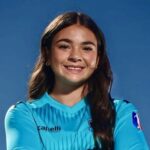Dismantling the Dagwood sandwich: An equation for healthy youth sports
By Dr. Wendy Lebolt
Editor’s note: This is the latest column from Dr. Wendy Lebolt, a longtime coach and physiologist who is the founder of Fit2Finish, a Northern Virginia-based training, fitness and rehabilitation company which works with teams and individual players to maximize health and performance. The Soccer Wire is excited to present Wendy’s learned perspectives on the mental, physical and psychological aspects of the beautiful game. Learn more about her background here.
Everybody’s talking about injuries. Coaches, doctors, league administrators and parents are worried about the increase in injuries from SO much soccer! Kids are stuffed with teams and tryouts, tournaments and competitions. What used to be a tasty part of a balanced diet, now sits on their plate like a dagwood sandwich, daring them to eat it all.
I believe competitive sports, including soccer, are good for kids but currently they’re killing ours. When I mention this to teams, families, coaches and kids I work with, most agree but everyone points the accusing finger of blame at someone else. (For more on this, read Warrior Girls: Protecting Our Daughters Against the Injury Epidemic in Women’s Sports, an excellent book by Michael Sokolove, which paints the issue in living color.)
A friend who coaches at a nearby college told me, “All five incoming freshman we recruited for the fall season are injured. Knees, concussions, overtraining injuries. [Too much] soccer is killing them.”
Too much of anything, even a good thing, is a bad thing. So, whose fault is it? Who is to blame? I’d say all of us to some extent, and we need to have some hard conversations.

To parents I want to say:
- If your kid wants to quit, find out why they’re dissatisfied. Help them list what irks them about the team or the sport or the coach or your behavior on the sidelines.
- Honor this. Believe this. Address each issue.
- If the kid still wants to quit and their reasons are sound, let them.
- If they want to add a team, an activity, a new piece of clothing, they must subtract. Basketball? Okay, then not so much soccer. Swim team? Okay, then not all those kick-arounds.
- Make it an “or” not an “and” …choose. Don’t layer. Don’t stack the dagwood.
To coaches I want to say:
- Don’t make them play. Telling them you need them out there is undue pressure.
- Don’t pay their way. This is bribery. (I’ve seen this)
- Don’t promise what you can’t provide.
- If you’re always looking for the next best thing down the pike, you’ll probably find it. Don’t treat kids like currency.
- Believe parents are doing the best they know how. Start there to help them be better.
To kids I want to say:
- Don’t talk your parents into one more game, one more team, or one more activity.
- Despite what our culture and your parents’ world tells you, more is not better.
- If it hurts, stop. Period. That includes physical, mental, emotional or spiritual hurting.
- If the discomfort continues, tell someone you trust.
- Believe your parents are trying to do their best, and they’ll be better at it. Just watch us.
- Insist your coach show you the game until it clicks for you, and they’ll be better. Just watch us.
- Trust the voice inside of you that says you can be so much more. Just watch you.
Parents and coaches, if we want our kids to keep achieving in sports we need an accounting of how much they’re playing. How much are we piling on their Dagwoods? Then, instead of blame, finger-pointing and sad shaking of heads, we need a strategy for unpiling that keeps what’s on their plate healthy and tasting good.
Recently, some researchers at Loyola University Medical Center waded into this issue. They looked at more than 1200 young athletes who had been injured in sports and the hours they devoted to a single sport vs. other activity. Their finding: kids who played a single sport more hours per week than their age were 70% more likely to experience an overuse injury. They proposed, “Children shouldn’t spend more hours per week than years of their age playing one sport.”
People like quantification and this report was picked up by the newswires and touted as a great recommendation. Did anyone really do the math here?
Let’s look at that. In the name of reducing injury, it says my 12 year old can participate in:
- 4 x 2 hour soccer practices (8 hours of practice!/week)
- and play in 4 x 60 minute games (4 hours of competition!) that weekend.
- That equals 12 hours.
Really? Does that sound healthy to you? And these researchers focused on the single sport whammy, so why not add basketball and swimming right on in there? That’s a towering sandwich and my kid thinks he’s supposed to clean his plate.
This is (can I just say it?) insane. The researchers have identified the culprit as too much of one sport, but have no idea the intensity at which our 12 year olds are playing. These are scientists after all.
(Disclaimer: I am a scientist.) Let’s not even get into the issue of multiple, highly competitive sports which come into play with our most athletic kids.
We need to dismantle the Dagwood sandwich. Yes, the meal we’re serving is not working. But what’s the recipe for a healthy meal?
I propose an accounting system for how much of our kids (how many hours and at what intensity/level) we are spending. Here’s a possible formula:
_____ Hours of any sport practice x 2.5 = ______
_____ Hours of any sport competition x 3.5 = ______
*Total = ______
- The *total number should not exceed their age. ( a 12 year old gets a max of 2 x 1.5 hr practices and 2 x 1 hr games per week)
- It should include every activity in which they train or compete.
- If they play something completely recreationally (ie. jump rope, tiddlywinks), the research says, this should reduce their injury risk, so go for it.
This is simply a model, a place to start. Models are there for us to try out, argue about and make better.
Rather than silence and grumbling, we can have a conversation.
Parents, if the kid asks for more, show him options and offer a choice.
Kids, if the coach begs you to play, make him an offer: “I can give you ____ minutes this week.”
Coach, if a parent insists that their kid get more playing time even though they’re coming from a weekend long basketball tournament, show her the statistics, and the rule you follow.
Let’s chew on this together. Maybe over a sandwich. I’ll take turkey and swiss on whole wheat; hold the mayo.
Special thanks to: Gerardo Ramirez, ODP coach and full-time coach at Vienna Youth Soccer, whose heart for his players inspired this article, and Dirk Vandeveer, Assistant Coach with GMU women’s soccer team, who suggested the multipliers for the healthy sandwich equation.
SOCCERWIRE MARKETPLACE
- Wanted Licensed Youth Soccer Coach
- Join Official Elite Summer Soccer Camps with Europe’s Top Pro Clubs!
- The St. James FC Travel Staff Coach - North (Loudoun) & South (Fairfax)
- The St. James FC Girls Academy (GA) Head Coach - 2 teams
- The St James FC Boys Travel Tryouts
- OFFICIAL BAYERN MUNICH SUMMER CAMPS U.S.
- JOIN THE ALLIANCE!
- OFFICIAL FC BARCELONA CAMPS U.S.
- The Cup San Diego - Hosted by Legends FC
- Players Wanted - Undergraduate or Post-graduate











